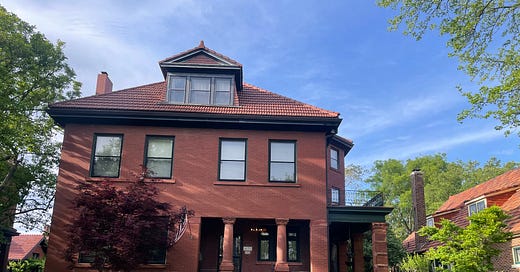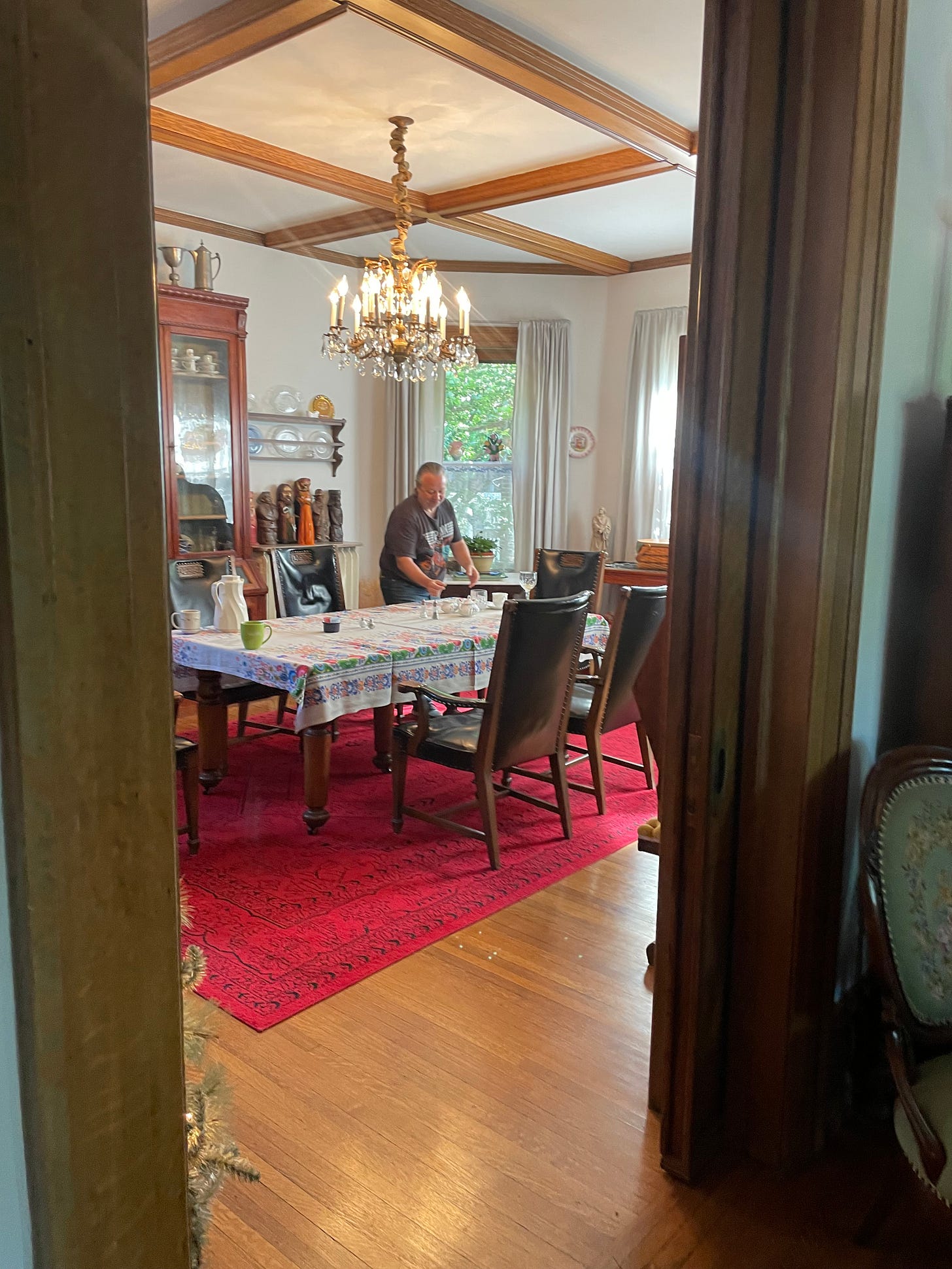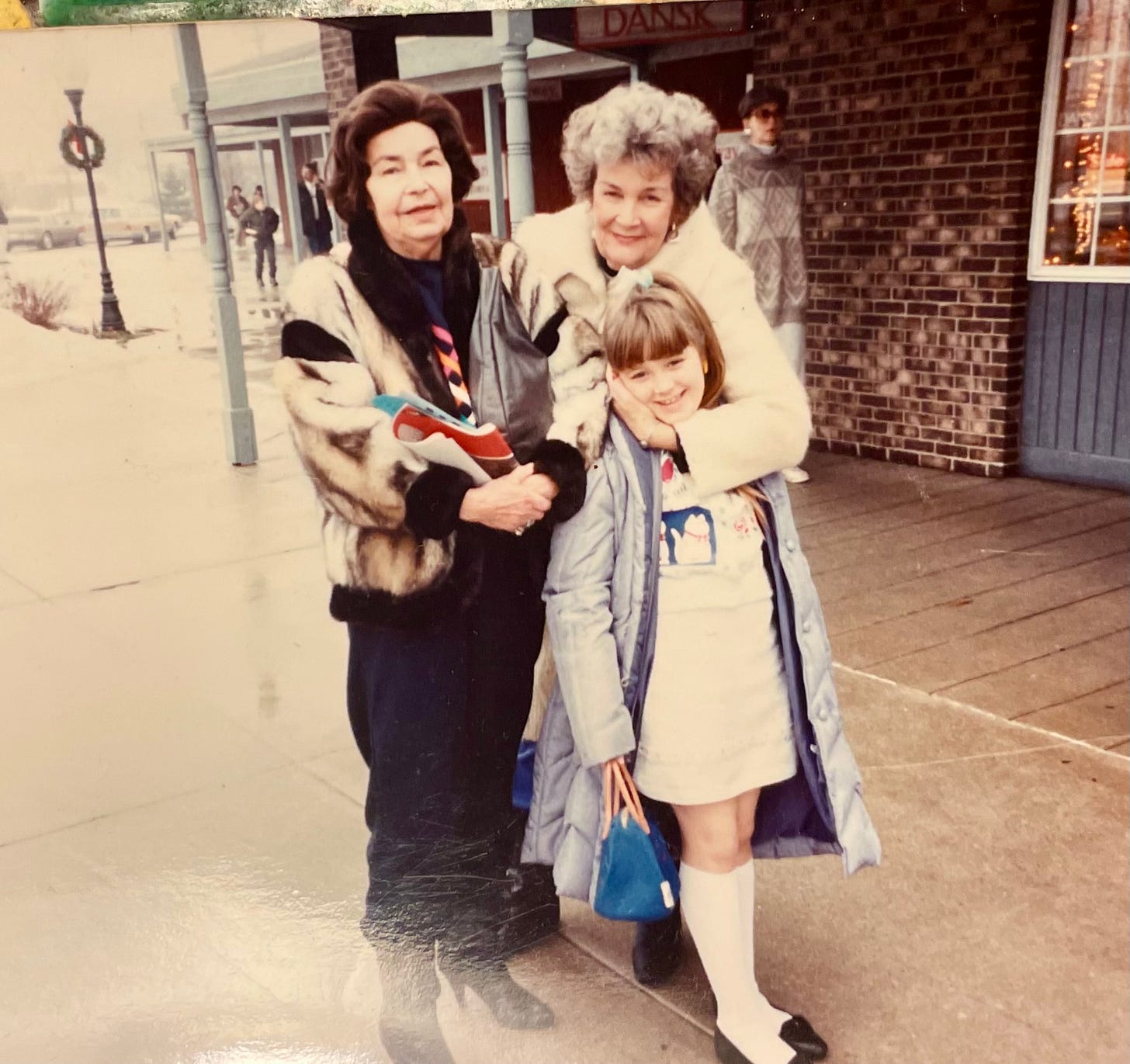Presented with advance apologies for any mistakes in the family history, should any relatives be reading.
It had been gray all morning, but the sky had finally cleared by the time my friend and I left the coffee shop this Saturday afternoon. Walking together back toward my street parking spot, she spotted an open house sign just across from where my car sat, baking in the now-visible sun. “You game?” she asked me.
And certainly I was. It’s always fascinating to sneak a peek at what’s behind the front door of a home you’ve walked past dozens (or hundreds) of times. Would it be secretly bigger on the inside? Would there be a surprise swimming pool out back? Some shockingly ugly DIY remodeling effort?
The first thing I observed about the interior of this house was that it “looked old.” I couldn’t quite put my finger on it, but it went beyond the antique bed frames and studiously vintage decor. Was it the woodwork at the doorframes? The way one bedroom led directly into another?
We weren’t the only lookie-loos in the house, so we managed to avoid the realtor for quite a while. When we finally encountered her, I offered a compliment as a token of gratitude for our entry. “I love this window seat,” was my meager, but honest, comment. An upholstered cushion sat atop an extra-wide sill, running all along three east-facing windows.
“It’s original!” the realtor countered with pride. “The house was built in 1904.”
Well! There was our open house snoopers’ surprise! Did Los Angeles even exist in 1904? I wondered. We learned that the fireplace, while original, was now non-functional. Not original was the second bathroom (which had once been a pantry) and the entire front room of the house (which had once been nothing more than a front yard).
History and interior design are both interests of mine, but neither occupies enough of my day-to-day to qualify me as an expert, or even a true hobbyist. A dabbler, perhaps, in the way a born generalist must be a master-of-little by definition and disposition. But this 1904 business, combined with the question of what “original” house remained to admire…this bore a stunning symmetry to my overnight visit to the Casa Magnolia Bed and Breakfast in St. Louis just a few weeks earlier.
The house sits on Magnolia Blvd. in the historic Shaw neighborhood, not far from the impressive Missouri Botanical Garden, and immediately facing the north edge of Tower Grove Park. It was built in 1906, and in 1915 was sold to Charles Galloway, who had been the organist at the 1904 St. Louis World’s Fair. All of this I learned from the B&B’s website, though much was also shared with me by Jordi, one of the proprietors, as he gave me a tour of the three-story estate. My father and uncle, who had driven me over, came along for a glimpse inside.
Anyone entering the house would tell you it was like stepping back in time — wood floors and banisters, needlepoint upholstery, and all the antique memorabilia the eyes can old. As we walked from room to room, Jordi pointed out the many changes he and his wife, Lillabet, had made after buying the house almost 30 years prior. Nearly every change was a restoration to the house’s original blueprints, which they’d miraculously found in the attic.
There was a whole wall of the dining room now filled with light, where windows had once been bricked over. Black paint, once a fashionable choice, had been stripped from the walls and moulding. That was just a start! A passageway between the dining room and kitchen had been reopened to allow more flow and easier access to the direct third-floor staircase. The crumbling garage had been rebuilt and the grass around the pool out back replanted. The counters and appliances in the kitchen had been rearranged, and upstairs a bathroom had been added to the back bedroom where I’d be staying — one of the few edits that had not been a part of those original blueprints.
Did every guest get such a thorough tour? I have no idea. But this tour was undoubtedly a novel experience for Jordi himself. At every turn, my father — known among his siblings as the one who “remembers everything,” despite his protests that his memory isn’t what it once was — chimed in with color commentary. For every bedroom, he threw out the name of the cousin who used to call in their own. At the third floor stairwell, the story of my first splinter. As we looked out at the back patio, Dad told the story of how Uncle Dave brought home $100 of illegal fireworks and set them off over the pool.
I piped up too, pointing out that what was now the sunny dining room had once held an L-shaped sofa (that would have blocked the new passageway) and an ancient TV set, the kind with a dial. What was now the front parlor had, I thought, been a rarely-used dining room. The walls of my bedroom for the night had once been completely plastered with signs and posters.
Charles Galloway — that organist who bought the house in 1915 — was the father-in-law of my Great Aunt Patty (born Patricia McCown), eldest sister of my mom’s mom. Charles, Jr. had inherited the house from his father, making it the childhood home of the couple’s many children — my mother’s first cousins. Charles, Jr. died young and Patty eventually got remarried to Uncle Dave, of whom I have fond memories. They had a son together, whose remodeled former bedroom would now be my lodging for the night.
Throughout my childhood, I’d come to “the House on Magnolia” (as my grandmother always referred to it) yearly, either for a summer visit or as a first stop on the multi-day drive to New Mexico at Christmas. But in the mid-’90s, my great aunt died, and Uncle Dave sold the house not terribly long afterward. I had not seen the place in 30 years. I’d known about the B&B for a while before finally booking my stay. I’d daydreamed about what it might be like to set foot inside again. At last, I’d slaked my curiosity.
I inherited my father’s strong memory. If you’d asked me at any time in the past three decades, I’d have told you that my memories of Aunt Patty’s house were vivid. Something funny though: when I booked my one-night stay (along with a note describing my connection to the house), Jordi had written back excitedly hoping for stories from the past. And I’d been thinking about it. For weeks, I thought about it. And yet, I had little to share. Or, little that I thought would be meaningful to the owners and restorers.
I remembered that old TV set, and the fact that it still worked, even if it could only receive a few channels. I remembered an old 7-Up cooler in the basement. I remembered the splinter from the attic floor, and that extremely cool papered-over bedroom wall. I remembered learning, in that pool, which of our cocker spaniels liked to swim, and scheming to teach my cousin Meghan to swim in it too. I remember my aunt cooking eggs all morning in the kitchen, wig not yet in place, chain smoking. She’d kiss me on the cheek, but not miss a beat at the stove. I remember Uncle Dave’s convertible, and the time we saw someone painting en plein air in Tower Grove Park. I remember being in awe of the house — its size, its fullness. It was an ideal place for a young only-child to fantasize. Ironic, then, that it had raised…seven children? Eight? Many.
By far my most vivid memory of the House on Magnolia (other than the constant, pervasive cigarette smell, to which I was unused in my normal life) is of sitting on that L-shaped couch with my grandmother. It would have been one of the rare times we were there together, as she lived in New Mexico and we in Chicagoland. I am reciting the Lord’s Prayer for her, showing her how I know it by heart. I get to the end. “…for the kingdom, the power, and the glory are yours,” I say. “Now and forever, Amen.”
My grandmother sighs wistfully. She liked it better, she tells me, with the words “for ever and ever.” The old way. “Forever and ever, Amen.” There was just something nice about it.
Who can say why some moments dissolve away and others the brain holds fast, not merely an artifact in the recesses of memory, but displayed near its front row, to be picked up and admired at will? In this moment, my grandmother wasn’t trying to create a memory, or even a lesson. She was just stating a feeling. Yet I think about that exchange all the time.
Truly. All the time.
I had a lovely stay at Casa Magnolia. I took a walk around the historic neighborhood (something I never remember doing as a kid). I watched an old movie in bed that night, and poked around a bit the next morning before joining the other guests for a feast of a breakfast. There was a couple, maybe in their 50s — a pair of doctors whose son and daughter-in-law were also doctors. The younger pair would soon be moving to St. Louis for their residencies, so the parents were on the hunt for someplace for them to live. This brought a new flavor to the ongoing conversation of historic home renovation. The doctors shared that they’d gone inside some other seemingly stately homes in the area and seen that many owners hadn’t been as careful with their restorations as Jordi and Lillabet had. Some had, in fact, been pretty careless, flaunting local building codes in the process.
As the hosts described the lengths they’d gone to in order to install the approved type of glass in the dining room’s added windows, the other guests grew bewildered as they tried to picture how dark and cavernous the now-sunlit room must’ve been. And the thing is, they weren’t wrong. Objectively speaking, the room was much nicer this way. But for me, that cavernous room was the one that had played host to my Lord’s Prayer memory, and countless others. It was prettier now, but it was different.
I can say honestly that I was expecting “different.” I was expecting the whole house to look different than when I was a kid. And while a great many changes had been made — and at great expense — I was relieved that the house was still recognizable as the place I’d spent so much time in my youth. But all this talk of “restoration,” of returning an old home to its original grandeur, got me thinking about what it is, exactly, that those of us with such impulses are really trying to accomplish. We want to create a space that honors history. But in the absence of people, in the absence of memories, the history we’re honoring is purely an aesthetic one.
What’s more, it kind of has to be that way. We can uncover blueprints, source the right materials, and display the perfect period antiques, but we can’t conjure and share a home’s true legacy — its memories — with people who weren’t there to make them.
Maybe, then, I should have shared my weirdly specific little non-stories from Aunt Patty’s house with the group. At the risk of dominating the breakfast conversation, perhaps I would have evoked more of the actual history of the house than all the construction, research, and money in the world ever could.
One piece of information that was shared with me multiple times during my short stay at Casa Magnolia was that “the kids” — my mother’s adult cousins — had come by the house occasionally in the days and months after the current owners had purchased it. It all sounded friendly — after all, the reason Dave had elected to sell the house to Jordi and Lillabet was that he liked them. And I think he trusted them. They cared what happened to the house. His trust was not misplaced. But eventually, I was told, the kids stopped coming around, and that was long ago.
This fact seemed to sadden Jordi somewhat, but I can’t say it surprised me. The house they were trying to visit was disappearing around them every time they returned. The house had been their old place when Dave sold it; now it was something else.
For me, far more emotionally and temporally removed from the house, the return visit worked as a walk down Memory Lane. It was almost as if I could see right through the shelves of antiques and the vintage furniture to the place I’d visited as a child. As I looked and remembered, something incredible dawned on me, the kind of realization it takes the course of a lifetime to earn. The old house hadn’t merely appealed to my budding sensibilities; it had shaped them.
Anyone who visited my teenage bedroom can tell you about “The Wall.” The A-frame sides of my attic room were collaged from top to bottom with magazine cuttings, quotes from friends, doodles and homework assignments. And whose walls do you think put that idea in my head? When we moved out of my own childhood home, I took The Wall down piece by piece and saved as much of it as I could in a big scrapbook that sits atop my bookshelf even now.
Bored in small town Indiana, some teens turned to drugs, alcohol, or organized sports. My best friends and I went to the antique mall downtown. We could wander for hours there, pointing at the accumulated ephemera of decades and decades, all mixed together in one big building. Is it a stretch to think I could’ve been filling the hole left by the unceremonious disappearance of the House on Magnolia from my life?
When I sat on the couch with my grandma in that house’s relatively windowless room, my family’s connection to church and music was already generations deep (though the fact that the house had once belonged to an organist is a fun new detail). But I wonder, when I started singing at an Episcopal church in my 20s, what was it that spoke to me about the liturgy? So much so that now, all these years later, I am effectively an Episcopalian? I’m not sure. But I’ll say this:
In the church where I sing and worship every Sunday, we say the Lord’s Prayer using the flowery language that my girlhood parishes had left behind, the ones that hearken back to another time. “Thine is the kingdom,” we say. “And the power and the glory. For ever and ever.”
And my grandma was right. There’s just something nice about it.








I thought of a correction. The old windows in what is now the dining room were not bricked over. Mom just always kept the drapes closed. I don't know why.
Marissa, John sent me your essay about Casa Magnolia. It's wonderful. Almost made me cry. I'm glad you have some vivid memories of our house. I love the one of the Lord's Prayer. I loved your Ammy; she was a special lady.
I hadn't thought of the old “studio” as we called it. It was dark. We called it the “studio” because it was where Grandpa Galloway had 2 grand pianos and a pipe organ. On Sundays in the summer, Grandpa would give “concerts”. He would open the windows, and people would sit in the park listening.
Do you still go to the Episcopal church? My daddy was the organist and choir director at St. Pater's Episcopal in Ladue when he died. Since it was so far away, we joined St. John's on Arsenal, on the other side of Tower Grove Park. Went there until our teens.